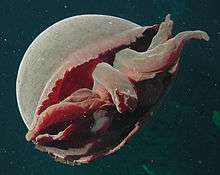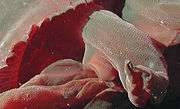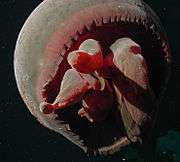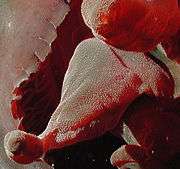Tiburonia
Tiburonia is a genus of jellyfish in the family Ulmaridae. It was reported in 2003, following the discovery of its only species yet identified, Tiburonia granrojo. It was discovered by a crew from MBARI led by George Matsumoto.[2] Its genus was named Tiburonia after the ROV the crew were using, called Tiburon, meaning "shark" in Spanish. Its species name was originally to be called "big ugly", but Kirsten Matsumoto raised objections to this name, and renamed it granrojo, meaning "big red" in Spanish.
| Tiburonia | |
|---|---|
 | |
| Scientific classification | |
| Kingdom: | Animalia |
| Phylum: | Cnidaria |
| Class: | Scyphozoa |
| Order: | Semaeostomeae |
| Family: | Ulmaridae |
| Subfamily: | Tiburoniinae Matsumoto et al., 2003[1] |
| Genus: | Tiburonia Matsumoto et al., 2003[1] |
| Species: | T. granrojo |
| Binomial name | |
| Tiburonia granrojo Matsumoto et al., 2003[1] | |
Tiburonia granrojo is one of the largest sea jellies and unusual in a number of ways. They live at ocean depths of 600 to 1,500 metres (2,000 to 4,900 ft) and have been found across the Pacific Ocean in the Gulf of California, Monterey Bay, Hawaii and Japan. It is very likely that these jellies are exhibiting deep-sea gigantism. They can grow up to 76 centimetres (30 in) in diameter,[1] according to the California Academy of Sciences, and have thick fleshy oral arms in place of the long tentacles found in most jellies. The entire jellyfish is deep red in color.[3]
To date, only 23 members of the species have been found and only one—a small specimen under 15 centimetres (6 in)—has been retrieved for further study. Several high resolution videos of granrojo have been taken by remote controlled submarines. The discovery was announced by Dr. Matsumoto and colleagues in Marine Biology in 2003.[1]
References
- Matsumoto, George I.; Raskoff, K. A.; Lindsay, D. J. (July 2003). "Tiburonia granrojo n. sp., a mesopelagic scyphomedusa from the Pacific Ocean representing the type of a new subfamily (class Scyphozoa: order Semaeostomeae: family Ulmaridae: subfamily Tiburoniinae subfam. nov.)". Marine Biology. 143 (1): 73–77. doi:10.1007/s00227-003-1047-2.
- "Dr. George I. Matsumoto, Ph.D". MBARI.
- Perlman, David (2003-05-07). "Mysteries of the Animal World: New Jellyfish: Big Red has cluster of arms, not tentacles". San Francisco Chronicle. p. 1. Retrieved 2008-07-16.
Further reading
- Raskoff, K. A.; Matsumoto, George I. (February 2004). "Stellamedusa ventana, a new mesopelagic scyphomedusa from the eastern Pacific representing a new subfamily, the Stellamedusinae". Journal of the Marine Biological Association of the UK. 84 (1): 37–42. doi:10.1017/S0025315404008884h.
- Osborn, Dawn Alexandra; Silver, Mary W.; Castro, Carmen G.; Bros, Shannon M.; Chavez, Francisco P. (August 2007). "The habitat of mesopelagic scyphomedusae in Monterey Bay, California". Deep-Sea Research Part I: Oceanographic Research Papers. 54 (8): 1241–1255. doi:10.1016/j.dsr.2007.04.015.
- Lindsay, Dhugal J.; Furushima, Yasuo; Miyake, Hiroshi; Kitamura, Minoru; Hunt, James C. (November 2004). "The scyphomedusan fauna of the Japan Trench: preliminary results from a remotely-operated vehicle". Hydrobiologia. 530–531 (1–3): 537–547. doi:10.1007/s10750-004-2645-9.
External links
- Article in the California Academic of Sciences' Science Now (Several high quality images)
- Article for National Geographic Today
- Report in Innovations Report
- Release in MBARI News
- Big Red Jellyfish | Smithsonian Ocean Portal


